Practical guidance on modeling choices for the virtual twins method
- PMID: 36876989
- PMCID: PMC10480344
- DOI: 10.1080/10543406.2023.2170404
Practical guidance on modeling choices for the virtual twins method
Abstract
Individuals can vary drastically in their response to the same treatment, and this heterogeneity has driven the push for more personalized medicine. Accurate and interpretable methods to identify subgroups that respond to the treatment differently from the population average are necessary to achieving this goal. The Virtual Twins (VT) method is a highly cited and implemented method for subgroup identification because of its intuitive framework. However, since its initial publication, many researchers still rely heavily on the authors' initial modeling suggestions without examining newer and more powerful alternatives. This leaves much of the potential of the method untapped. We comprehensively evaluate the performance of VT with different combinations of methods in each of its component steps, under a collection of linear and nonlinear problem settings. Our simulations show that the method choice for Step 1 of VT, in which dense models with high predictive performance are fit for the potential outcomes, is highly influential in the overall accuracy of the method, and Superlearner is a promising choice. We illustrate our findings by using VT to identify subgroups with heterogeneous treatment effects in a randomized, double-blind trial of very low nicotine content cigarettes.
Keywords: Virtual twins; causal inference; machine learning; personalized medicine; precision medicine.
Figures






Similar articles
-
A permutation procedure to detect heterogeneous treatment effects in randomized clinical trials while controlling the type I error rate.Clin Trials. 2022 Oct;19(5):512-521. doi: 10.1177/17407745221095855. Epub 2022 May 9. Clin Trials. 2022. PMID: 35531765 Free PMC article.
-
Multiplicity-adjusted semiparametric benefiting subgroup identification in clinical trials.Clin Trials. 2018 Feb;15(1):75-86. doi: 10.1177/1740774517729167. Epub 2017 Oct 16. Clin Trials. 2018. PMID: 29035083 Free PMC article.
-
The optimal dynamic treatment rule superlearner: considerations, performance, and application to criminal justice interventions.Int J Biostat. 2022 Jun 16;19(1):217-238. doi: 10.1515/ijb-2020-0127. eCollection 2023 May 1. Int J Biostat. 2022. PMID: 35708222 Free PMC article.
-
One Size Does Not Fit All: Methodological Considerations for Brain-Based Predictive Modeling in Psychiatry.Biol Psychiatry. 2023 Apr 15;93(8):717-728. doi: 10.1016/j.biopsych.2022.09.024. Epub 2022 Sep 29. Biol Psychiatry. 2023. PMID: 36577634 Review.
-
From Real-World Patient Data to Individualized Treatment Effects Using Machine Learning: Current and Future Methods to Address Underlying Challenges.Clin Pharmacol Ther. 2021 Jan;109(1):87-100. doi: 10.1002/cpt.1907. Epub 2020 Jun 28. Clin Pharmacol Ther. 2021. PMID: 32449163 Review.
Cited by
-
A permutation procedure to detect heterogeneous treatment effects in randomized clinical trials while controlling the type I error rate.Clin Trials. 2022 Oct;19(5):512-521. doi: 10.1177/17407745221095855. Epub 2022 May 9. Clin Trials. 2022. PMID: 35531765 Free PMC article.
References
-
- Ilya L, Alex D, and Ralph B, “Tutorial in biostatistics: data-driven subgroup identification and analysis in clinical trials,” Statistics in Medicine, vol. 36, no. 1, pp. 136–196, 2017. - PubMed
-
- Breiman L, “Algorithm cart,” Classification and Regression Trees. California Wadsworth International Group, Belmont, California, 1984.
-
- Athey S, Tibshirani J, and Wager S, “Generalized random forests,” The Annals of Statistics, vol. 47, pp. 1148–1178, Apr. 2019. Publisher: Institute of Mathematical Statistics.
Publication types
MeSH terms
Grants and funding
LinkOut - more resources
Full Text Sources
